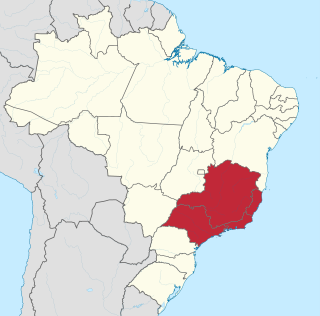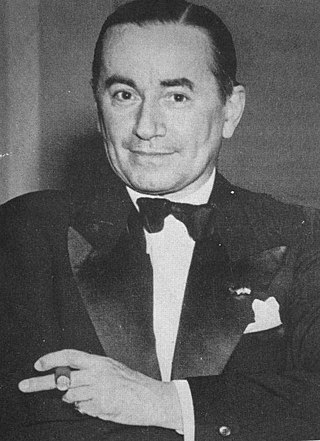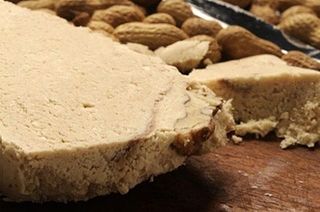
Espadrilles are casual, rope-soled, flat but sometimes high-heeled shoes. They usually have a canvas or cotton fabric upper and a flexible sole made of esparto rope. The esparto rope sole is the defining characteristic of an espadrille; the uppers vary widely in style.

The Southeast Region of Brazil is composed of the states of Espírito Santo, Minas Gerais, Rio de Janeiro and São Paulo. It is the richest region of the country, responsible for approximately 60% of the Brazilian GDP, as São Paulo, Rio de Janeiro, and Minas Gerais are the three richest states of Brazil, the top three Brazilian states in terms of GDP. The Southeast of Brazil also has the highest GDP per capita among all Brazilian regions.

Cervecería y Maltería Quilmes is an Argentine drink company founded in 1890 in the city of Quilmes in Greater Buenos Aires. The company was established by Otto Bemberg, a German immigrant, in 1890 as a beer manufacturer. Since 2002, Quilmes is owned by AmBev, the largest beer manufacturer in the world.
Topper is a sportswear brand established in Argentina and currently owned by Brazilian "BRS Comercio e Industria de Material Esportivo SA", headquartered in São Paulo. The brand is commercialised in South America, mainly in Brazil, Uruguay and Argentina, where it markets a wide range of products from footwear to clothing.

Florencio Molina Campos was an Argentine illustrator and a painter known by his typical traditional scenes of the Pampa. His work represents gauchesco scenes with a bit of humor.

Le Coq Sportif is a French manufacturing company of sports equipment. Founded in 1882 by Émile Camuset and located in Entzheim, the company first issued items branded with its now-famous rooster trademark in 1948. The company's name and trademark are derived from the Gallic rooster, a national symbol of France.

Hispano-Argentina was an Argentine automotive and engineering company that manufactured automobiles, military vehicles, engines, weaponry, and parts for public works.

BBVA Argentina, formerly BBVA Banco Francés, is a financial institution in Argentina.

Hesperidina is a classic Argentine apéritif made from bitter and sweet orange peels, which contain a high number of flavonoids. The beverage has antioxidant effects because of the flavonoids. Its name was taken from the Greek myth of Hesperides.

Havaianas is a Brazilian brand of flip-flop sandals created and patented in 1962. It is currently owned by Brazilian manufacturing company Alpargatas S.A. Inspired by Japanese zori sandals, Robert Fraser became the first to mass-produce flip-flops out of rubber. The name Havaianas is derived from the feminine form of the Portuguese word for "Hawaiians", and the pattern on the soles of the sandals is designed to resemble the straw soles of zori. Originally, all Havaianas featured white insoles with colored outsoles and straps. Because of their simplicity and low price, the sandals became rapidly popular with Brazil's lowest social classes. However, now their popularity is generalized and the brand controls 80% of the Brazilian rubber slippers market: in fact, of every three Brazilians, two on average consume a pair of "Havaianas" per year.

Mantecol is the brand name of a typical dessert of the cuisine of Argentina, a sort of semi-soft nougat made from peanut butter. It was originally created and marketed in the 1940s by the confectionery company Georgalos, founded by a Greek immigrant, Miguel Georgalos, who took the inspiration in a dessert of Greek cuisine, the halva.
Vulcabrasǀazaleia is a Brazilian footwear company, being the third largest in domestic market and in Latin America, only after Brazilians Alpargatas and Grendene. The company was founded in 1952 in São Paulo, but currently is headquartered in Jundiaí.

Signia is an Argentine sportswear brand which manufactures footwear and clothing. The brand has experienced some restructuring plans in the past due to financial problems, even disappearing from the market for some periods of time. Signia has also sponsored some Primera División football teams in Argentina, mostly at the beginning of the 2000s.
Alejandro Enrique Grullón Espaillat was a banker and businessman from the Dominican Republic.

Cablevisión S.A. was an Argentine company that provided cable television and internet services in its country of origin, Paraguay and Uruguay. Established in 1981, the company was acquired by the Clarín Group in 2006, then merging with Telecom Argentina. Cablevisión was the biggest cable TV provider in Argentina with 3,377,082 customers.
Rothy's is an American direct-to-consumer company which designs and sells shoes and accessories. Rothy's was initially founded in 2012 and launched in 2016 by Stephen Hawthornthwaite and Roth Martin as a women's shoe company in San Francisco. It has since expanded with handbags and a men's line.

José Ignacio "Vasco" de Mendiguren is an Argentine industrialist and politician. He was chairman of the Argentine Industrial Union, director of the National Bank of Argentina, and Minister of Production during the presidency of Eduardo Duhalde. From 2013 to 2021, he was a National Deputy elected in Buenos Aires Province, as part of the Renewal Front and later as part of the Frente de Todos.

Terrabusi is an Argentine food brand currently owned by US conglomerate Mondelez International. The former manufacturing company had been founded by the Terrabusi brothers in 1911, and soon gained a reputation as a cookies and crackers manufacturer, commercialising its products under several brands. In 1994, Terrabusi was purchased by U.S.-based company Nabisco, which would be acquired by Philip Morris Companies, Inc. in 2000. As a result, both food companies joined.

The Copa 50imo Aniversario de Clarín, was a friendly football match realized between Argentina and Brazil, on November 8, 1995.

Alpargatas S.A. is a Brazilian manufacturing company headquartered in São Paulo. Established in 1907, it is of the largest Brazilian companies in the footwears and canvass business.



















